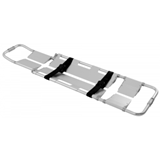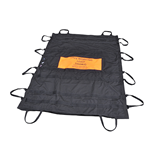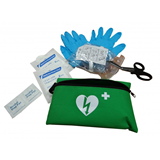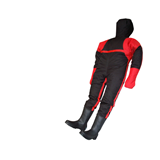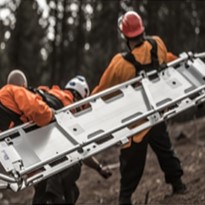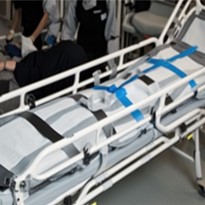In the realm of emergency medical response, the rescue stretcher stands as an indispensable tool, serving as a lifeline between life and death in critical situations. This pillar post delves into the meticulous design and essential features of modern rescue stretchers. Here, we navigate through the technical intricacies and functionalities that define these critical pieces of equipment. Our aim is to provide an informative, professional, and neutral perspective on the subject, ensuring that the discourse remains clear, concise, and authoritative.
I. Anatomy of a Rescue Stretcher
A. Frame
- Materials used for frame construction play a pivotal role in the strength and durability of a rescue stretcher. Key considerations in frame design encompass not only robustness but also adaptability to accommodate patients of varying sizes and weights.
- High-strength materials such as aluminum alloys, stainless steel, or carbon fiber.
- Reinforcement techniques and structural integrity.
- Load-bearing capacity and weight distribution.
B. Carrying Handles
- Carrying handles are a fundamental component of rescue stretchers, and their types can significantly impact maneuverability during emergency situations. This section discusses the various handle configurations, including integrated, detachable, and ergonomic grip options.
- Integrated handles for streamlined design.
- Detachable handles for versatility.
- Ergonomically designed grips for reduced strain on responders.
C. Straps
- Straps are critical for securely restraining patients on the stretcher during transport. This section dives into the materials used for straps and the mechanisms employed to ensure patient safety, focusing on adjustability and positioning for optimal restraint.
- Materials like nylon, polyester, or reinforced webbing.
- Fastening mechanisms, including buckles and quick-release systems.
- Customizable strap positioning for patient comfort and safety.
II. Lightweight and Durable Materials
A. Importance of Lightweight Materials
- The importance of lightweight materials cannot be overstated, as they directly influence the ease of handling a rescue stretcher, particularly in high-pressure, time-sensitive situations.
- Reduced responder fatigue and faster response times.
- Enhanced portability and maneuverability in confined spaces.
- Lightweight materials contributing to overall efficiency.
B. Discussion of Materials
- This section delves into specific materials commonly used in modern rescue stretcher construction, including aluminum, carbon fiber, and reinforced plastics, examining their respective advantages and disadvantages.
- Aluminum for its strength-to-weight ratio.
- Carbon fiber's exceptional strength and low weight.
- Reinforced plastics combining durability and cost-effectiveness.
C. Balance Between Lightweight Design and Durability
- Striking the right balance between lightweight design and durability is a crucial challenge faced by stretcher designers, as the equipment must withstand rigorous usage while remaining highly maneuverable.
- Engineering considerations for material thickness.
- Durability testing protocols and standards.
- Innovations that optimize both lightweight and durability aspects.
III. Foldable and Compact Designs
A. Benefits of foldable stretchers for storage and transportation:
- Improved Portability: Foldable stretchers offer enhanced portability, making them well-suited for emergency responders who must navigate tight spaces or remote locations.
- Space Efficiency: Folding mechanisms reduce the stretcher's footprint, allowing for efficient storage in rescue vehicles and tight quarters.
- Rapid Deployment: Quick access to a folded stretcher can be crucial in time-sensitive situations, contributing to faster response times.
B. Mechanisms for easy folding and unfolding:
- Hinged Joints: Many modern stretchers incorporate hinged joints with secure locking mechanisms, enabling smooth and controlled folding and unfolding.
- User-Friendly Operation: Intuitive design ensures that emergency responders can swiftly deploy the stretcher without the need for complex instructions or tools.
- Durability: Foldable stretchers are engineered to withstand repeated folding and unfolding, maintaining their structural integrity over time.
C. Considerations for compact storage in rescue vehicles:
- Compatibility: Rescue vehicle designs vary, so stretchers must be designed to fit within the available storage compartments or brackets.
- Secure Anchoring: Proper anchoring systems or storage brackets ensure that stretchers remain secure during vehicle movement, preventing damage or accidents.
- Accessibility: Easy access to stored stretchers allows for quick retrieval and deployment when emergencies arise.
V. Ergonomics and Comfort
A. Design elements focused on patient comfort during transport:
- Contoured Surfaces: Stretchers often feature contoured surfaces that conform to the natural shape of the human body, reducing pressure points and discomfort for the patient.
- Adequate Space: Ensuring sufficient space for patients, especially for those with injuries or medical devices, is essential for a comfortable transport experience.
- Ventilation: Adequate ventilation features prevent overheating or discomfort during prolonged use.
B. Padding, cushioning, and contouring for reduced discomfort:
- High-Density Foam: Padding made from high-density foam provides both comfort and support for patients during transport.
- Water-Resistant Materials: Cushions and padding materials are often designed to resist moisture and facilitate easy cleaning.
- Ergonomic Headrests: Some stretchers include adjustable headrests to further enhance patient comfort.
C. Height and angle adjustments for ergonomic handling by responders:
- Adjustable Handles: Stretcher designs may incorporate adjustable handles, allowing responders to optimize the stretcher's height for ergonomic handling.
- Variable Angles: Flexibility in adjusting the angle of the stretcher can assist responders in navigating different terrains or environments while ensuring patient stability.
- Training and Guidelines: Proper training ensures that emergency responders understand how to adjust and handle stretchers in a way that minimizes strain and discomfort.
VI. Integration of Safety Restraints and Adjustable Components
Safety is paramount when it comes to rescue stretchers. In emergency situations, where patients might be in critical condition, secure restraint systems and adjustable components are critical features that can make the difference between a successful rescue and a potential injury. This section delves into the various types of safety restraints and adjustable components found in modern rescue stretchers, highlighting their importance and compliance with safety standards and regulations.
A. Types of Safety Restraints
- Straps:
- Straps are fundamental components of a rescue stretcher's safety system.
- They are typically made from high-strength materials such as nylon or polyester.
- Multiple attachment points provide flexibility in securing patients.
- Straps are designed to withstand significant force, ensuring patient stability during transport.
- Quick-release mechanisms allow for swift and safe removal when necessary.
- Buckles:
- Buckles are commonly used in conjunction with straps to secure patients.
- They offer a reliable and adjustable fastening method.
- Buckles come in various designs, including side-release and center-release options.
- Their intuitive operation ensures that responders can quickly and securely fasten patients.
- High-quality buckles are made from durable materials to withstand demanding rescue scenarios.
- Quick-Release Mechanisms:
- Quick-release mechanisms are crucial for rapid patient extraction when time is of the essence.
- They are often integrated into the strap and buckle systems for easy access.
- Pulling a single lever or pushing a button releases all restraints simultaneously.
- This feature is especially critical in situations where patients need immediate medical attention.
B. Adjustable Features for Adapting to Different Patient Positions
- Variable Restraint Length:
- Modern rescue stretchers often feature adjustable straps that can accommodate patients of varying sizes.
- These straps can be extended or tightened to secure patients securely.
- Variable restraint length ensures that the stretcher can be used for both adults and children.
- Head and Foot Adjustments:
- Some rescue stretchers offer the capability to adjust the head and foot positions.
- This feature is essential for accommodating patients with specific medical conditions or for providing comfort during transport.
- Adjustable headrests and leg supports can make a significant difference in patient care.
- Tilting Mechanisms:
- Tilting mechanisms allow the stretcher to be inclined at different angles.
- This feature is particularly valuable in situations where maintaining a specific patient position is crucial, such as spine injuries or respiratory distress.
- Precise control over the angle of inclination enhances patient comfort and safety.
C. Compliance with Safety Standards and Regulations
- International Standards:
- Manufacturers of modern rescue stretchers are expected to adhere to international safety standards and regulations.
- These standards often cover aspects such as material durability, load capacity, and restraint system strength.
- Compliance ensures that rescue stretchers are designed and built to withstand the rigors of emergency response.
- Testing and Certification:
- Before being deployed for use, rescue stretchers typically undergo rigorous testing to assess their performance under stress.
- Certification by relevant authorities signifies that the stretcher meets the necessary safety criteria.
- Responders can have confidence in the reliability of certified rescue stretchers.
- Ongoing Maintenance and Inspection:
- To ensure continued safety and reliability, rescue stretchers should be regularly inspected and maintained.
- Proper care includes checking straps for wear and tear, verifying the functionality of quick-release mechanisms, and ensuring that all adjustable components are in good working order.
- Maintenance schedules should align with manufacturer recommendations and industry best practices.
In conclusion, modern rescue stretchers represent a critical nexus of advanced engineering and thoughtful design in the realm of emergency medical response. These indispensable tools are meticulously crafted to meet the demands of diverse emergency scenarios, prioritizing patient safety, comfort, and ease of use, while also considering the well-being of the responders. With lightweight yet durable materials, compact and foldable designs, and an array of adjustable features, these stretchers empower emergency responders to efficiently and safely transport individuals in distress. The integration of safety restraints and compliance with stringent standards further underscores their pivotal role in saving lives during critical situations. As technology and innovation continue to advance, the evolution of rescue stretchers remains essential in enhancing emergency preparedness and response, reaffirming their status as indispensable lifelines between peril and safety.

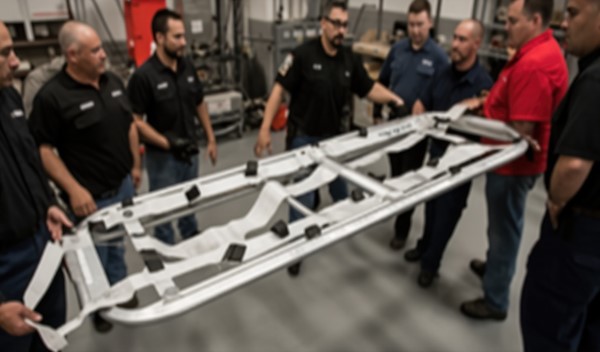


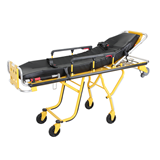
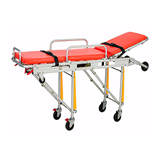

-160x160-state_article-rel-cat.png)




